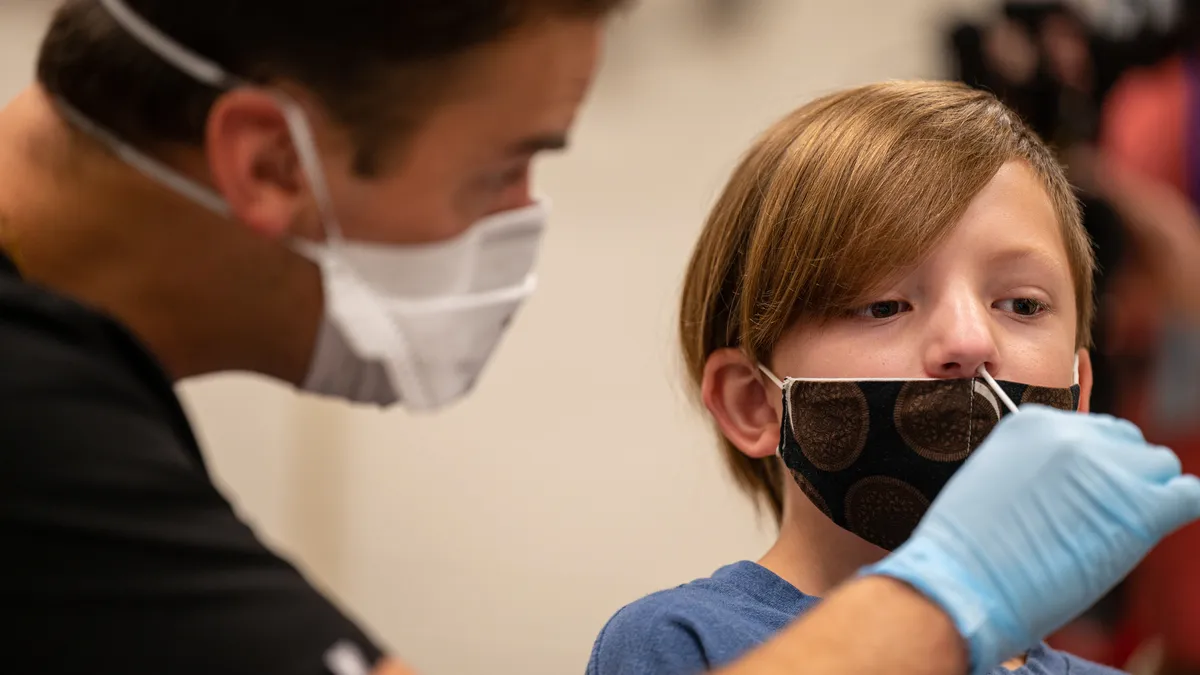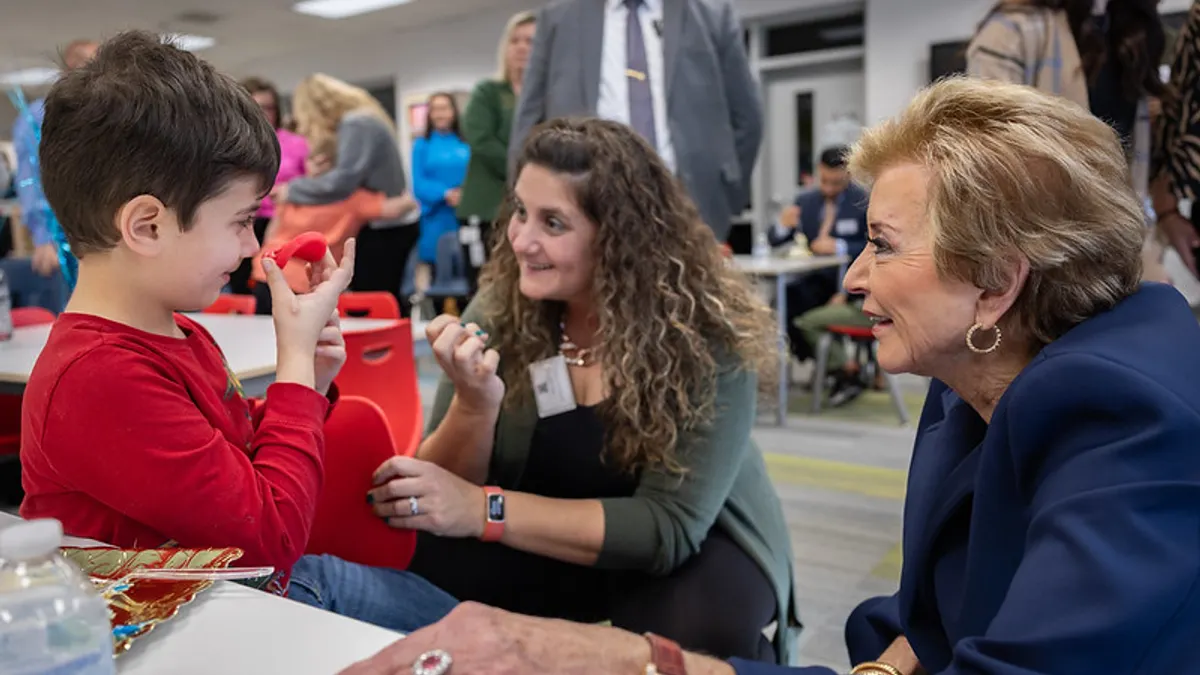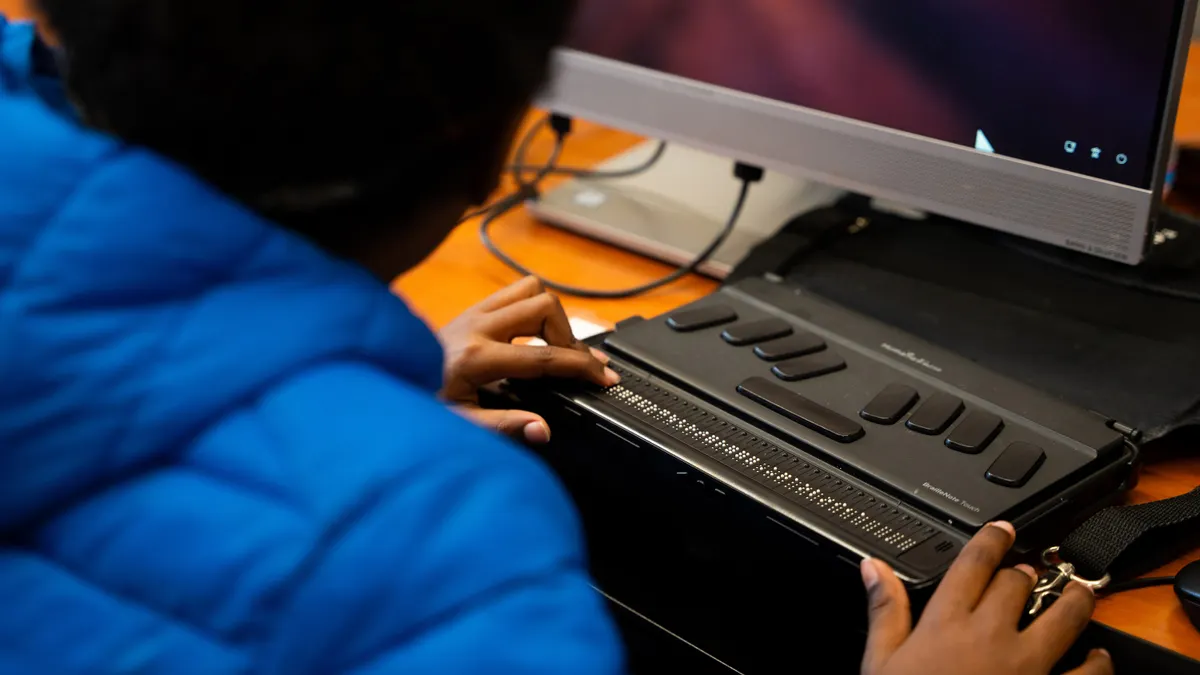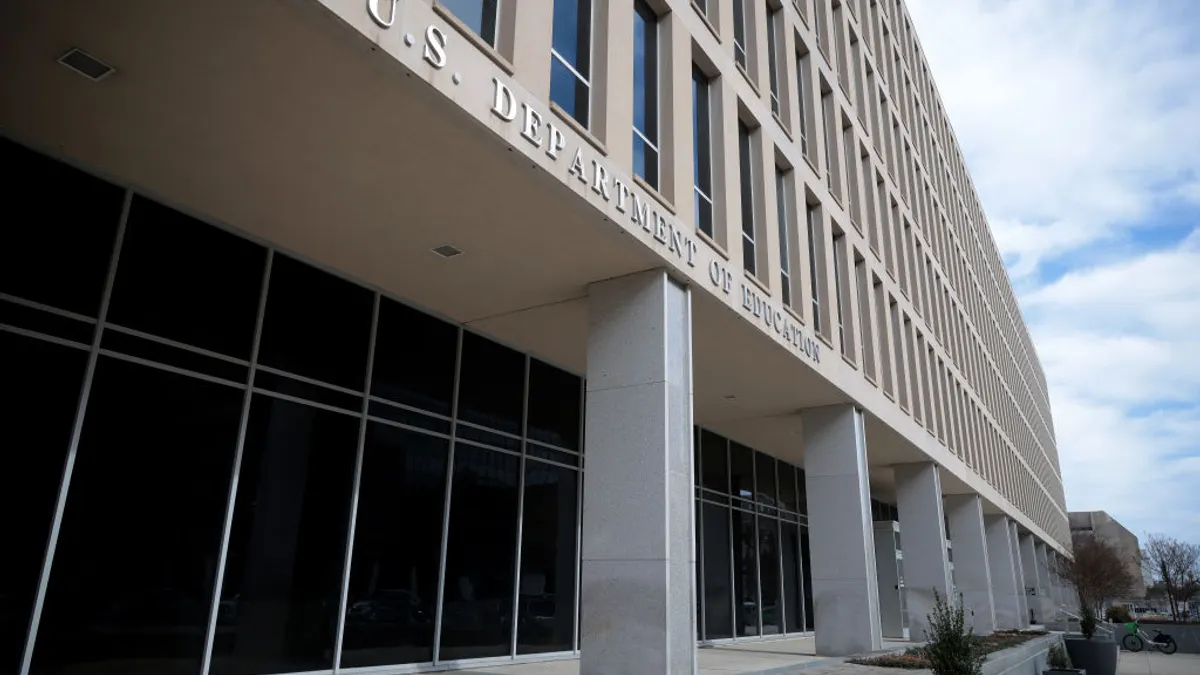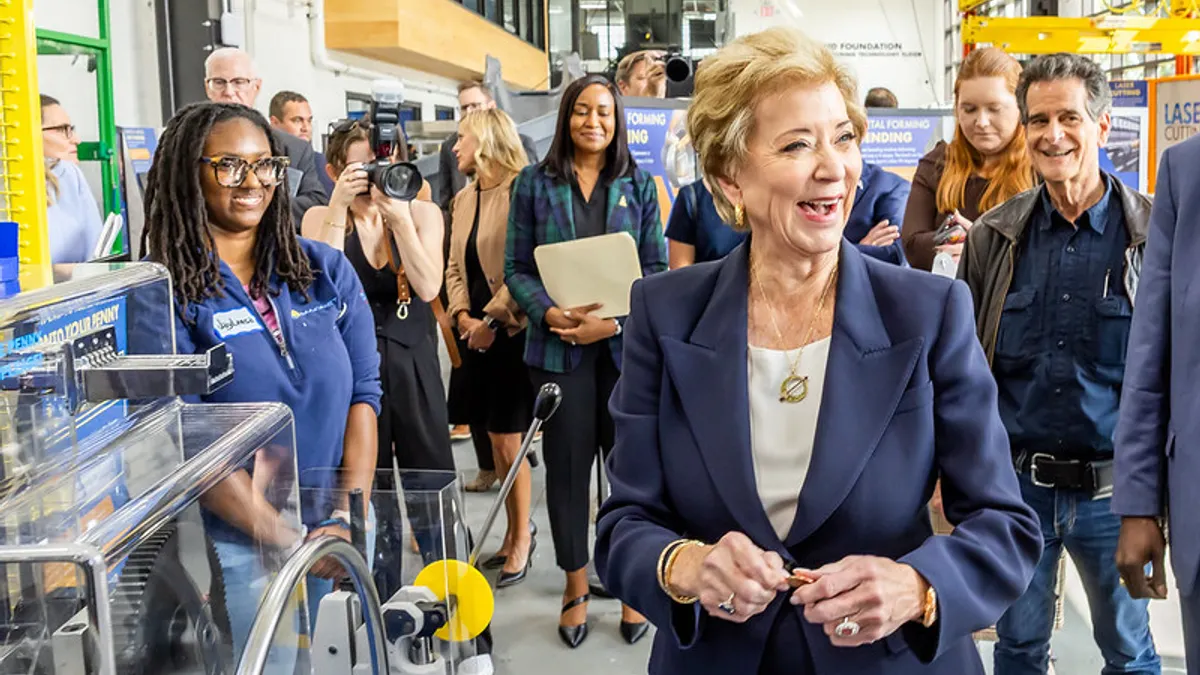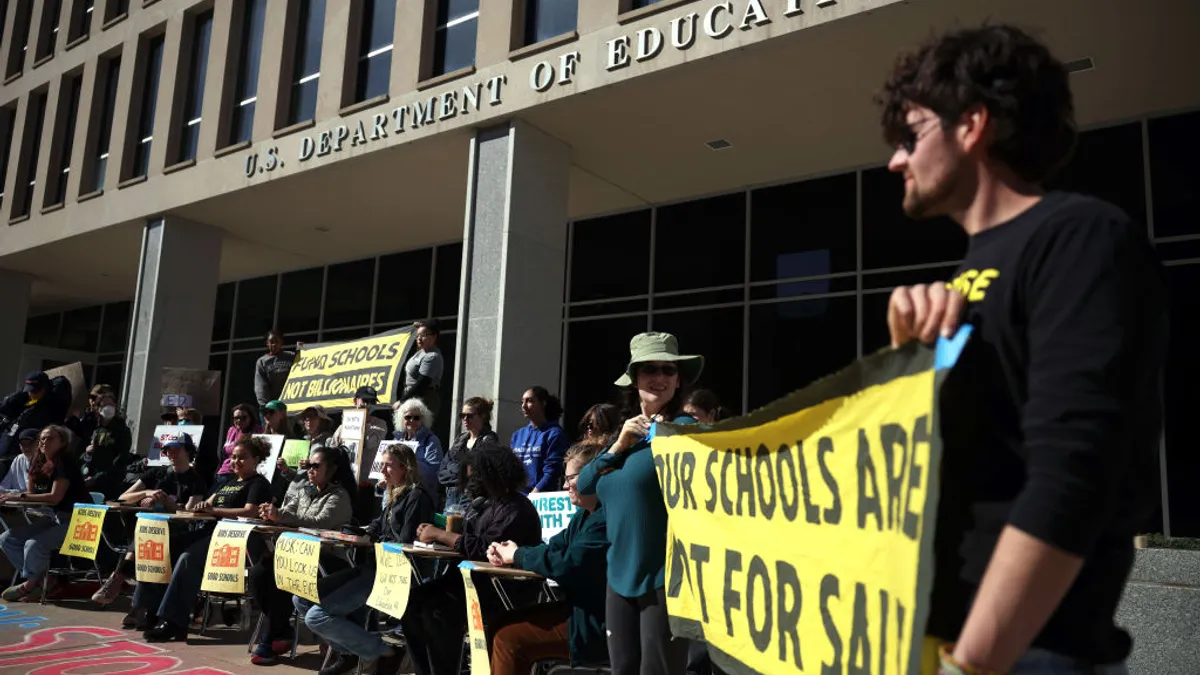Just months after the Biden administration announced a renewed effort to expand COVID-19 testing in K-12 schools — and weeks after the omicron-induced mad scramble for testing kits began — some districts say they plan to limit school-based testing or phase away from it altogether.
At the same time, however, other districts are intensifying campus-based testing efforts.
The wide variety in approaches to the types and timing of testing in schools across the country has education stakeholders guessing at the fate of school-led testing programs. They also wonder whether educators should instead put resources and energy into other mitigation strategies or double down on what has been a widely promoted safety practice since the first year of the pandemic for keeping students safe on campuses and for minimizing absenteeism.
Some say the momentum for school-based testing programs faded a bit in December and January, when schools — like municipalities and individual households — saw COVID-19 cases skyrocket but had limited access to rapid antigen test kits or received delayed results from PCR tests.
Increased pushback from parents and even some medical professionals for COVID-19 mitigation efforts also has some district administrators wondering how hard they can keep pushing for opt-in testing programs even while saying they’re a proven approach to keeping students in school.
The complexity of sustaining a somewhat predictable and equitable program for detecting a potential deadly virus amid staffing shortages, pressures to accelerate learning and other K-12 stressors can be overwhelming, school leaders say.
"I think at a high level, you're seeing school districts become extensions of public health agencies and having to educate parents about the importance of COVID-19 testing and vaccinations, and administrators taking on additional kinds of public health roles that they've never had to do before," said Ana Vasudeo, managing director of Safely Opening Schools and a director of the Berkeley Unified School District Board of Education in California.
Safely Opening Schools, an initiative of the Public Health Institute, works with the California Department of Public Health to provide technical assistance to schools on beginning on-campus testing programs.
Shifting practices
Running a routine screening testing program, which typically tests everyone on a weekly schedule, or a test-to-stay program, which tests people with known exposures detected through contact tracing, is much more involved than just having easy access to test kits and labs.
What types of tests to use, who and when to test, and the restrictions placed on those who test positive is often where complications run deep.
Do you have different testing policies for positive household close contacts versus verified positive school close contacts? What are the best protocols for testing students with significant cognitive disabilities? How is all this data tracked and kept secure?
These, and many others, are the questions vexing school leaders.
National and state guidance also changes regularly based on the changing status of the virus, forcing districts to alter course and continually explain shifting practices to staff and families.
In late December, updated guidance from the Centers for Disease Control and Prevention for reduced isolation and quarantine times, for example, suggested the possibility of using test-to-stay programs as an alternative to at-home quarantining for close contacts who test negative for COVID-19.
And in the past month, a handful of states including Connecticut, Vermont, Massachusetts and Ohio said they are no longer emphasizing test-to-stay programs and contact tracing. Ohio also is switching from reporting daily COVID-19 cases for K-12 schools and instead is requiring weekly reporting.
In some areas, school system leaders have to factor opposition to testing approaches into their strategies. Florida Gov. Ron DeSantis, for example, has criticized schools that require students and staff to have negative COVID-19 tests to stay on campuses, telling reporters in early January, “It’s not good policy to use testing as a tool to basically limit opportunity and limit people’s ability to get an education,” according to Politico.
Where the hurdles lie
As part of $10 billion in funding from the American Rescue Plan dedicated for COVID-19 testing in schools, each state had to submit school testing plans for how screening testing would be conducted, who would be tested, partners they were working with, and how they planned to use the funding.
Access to those funds, which flow from state health departments to districts, has not been a big barrier so far, several administrators, education advocates and testing vendors say. The hurdles have been accessing enough testing kits and, in a few areas, delays in accessing vendors to help school leaders coordinate testing efforts.
Last month, the Biden administration said it was sending 5 million rapid antigen tests and 5 million lab-based PCR tests per month to schools. While that news was welcomed, it won't meet demand, said Mike Magee, CEO of Chiefs for Change, an organization supporting state and district education leaders.
Those tests calculate to one test a month for one out of every five students in the U.S., he said.
"You know, we have members that are scouring their regions for tests right now and that's unnecessary and unfortunate," Magee said. An informal survey of Chiefs for Change members in early January found 80% of respondents said they were either out of COVID-19 tests or would be in a month.
The paperwork, electronic documentation and data management systems involved in preparing for and managing school-based testing — and tracking students who have been tested — are also pain points for school leaders.
"Part of why it's so challenging right now for school districts is because this is a level of strategic planning that many of them have never been asked to do before."

Mike Magee
CEO of Chiefs for Change
In the Berkeley Unified School District in California, Superintendent Brent Stephens said the district tests students twice a week with rapid antigen tests. Administering 20,000 tests a week requires contracted employees and "colossal volunteer efforts" to register and proctor the tests and assist with inputing data for reporting. The district allocated $2 million of local funding to build its testing program, Stephens said.
Although testing has been helpful in increasing confidence in detecting positive cases, Stephens said the system is not sustainable long term either financially or logistically. For a post-COVID-19 era, however, the district is planning to retain the basics of its testing program in case there's a need to scale-up response to future public health threats, he said.
"If I were encouraging legislators to think ahead to the summer and what next year would look like, it's that the districts must sort of maintain some infrastructure related to contact tracing and testing in order to be able to respond nimbly to whatever comes up," Stephens said.
Supports for districts
Chiefs for Change, like many education advocacy groups, has issued resources for school personnel on testing programs. The U.S. Department of Education has been hosting a series of webinars on strengthening school-based testing programs, with participation from CDC, the Rockefeller Foundation, school district leaders and others.
Additionally, Open & Safe Schools, a collaboration of federal agencies, has created extensive toolkits to help states and schools plan, budget and implement on-campus testing programs.
Laura Bronner, national K-12 testing program lead for Concentric by Ginkgo Bioworks, a school COVID-19 testing initiative through the synthetic biology company, helps coordinate different testing modalities in thousands of schools across 10 states. Most of the efforts center on pooled PCR testing, where nasal swabs from a group of students without symptoms are put into one large test tube and the group is tested as one sample. If that result comes back positive, further individual testing is conducted.
Before the omicron variant came into play, typically one out of 100 pooled tests would come back positive. Now, the numbers are much higher, Bronner said.
"We're learning on a daily basis about what's working and what's not working, but we're still keeping kids in school."

Laura Bronner
National K-12 testing program lead for Concentric by Ginkgo Bioworks
The most successful school-based testing programs have a schedule for testing weekly on the same day at the same time, she said. The company customizes operations to fit each school and state's needs, and the company has had to make shifts as localities' needs change.
"We're learning on a daily basis about what's working and what's not working, but we're still keeping kids in school," Bronner said.
A medical testing program in schools for a virus that didn't exist 26 months ago is not supposed to be simple, but it shouldn't overshadow other work school leaders have, said health advisors and education advocates.
"Part of why it's so challenging right now for school districts is because this is a level of strategic planning that many of them have never been asked to do before," Magee said.
Looking ahead
As complicated as school-based testing operations are, there's still widespread support for schools taking a lead role in testing because it provides an incentive to encourage in-person learning — and because schools are often the hubs of their communities, able to promote accessible and equitable testing.
Several health experts and educators predict schools will eventually phase out routine testing and test-to-stay programs and only test symptomatic students and staff. That, however, would depend on local positivity counts, the trajectory of the virus overall and local, state and national guidance.
A larger focus on home-based COVID-19 testing rather than school-managed programs could evolve but would need careful planning so all the responsibility isn't on families, said Lynn Silver, director of Safely Opening Schools.
"Until there is a clear and operational way to support families to home-test at no cost, schools will need to provide that service, and it will probably still be needed for people with symptoms at school for some time," Silver said.
She said there are many current and future challenges to consider, including how to maintain and fund school-based testing, and how and when to transition to home-based testing.
"And then the third question is, how long do we actually need it? And that's the $64,000 question," Silver said.
According to Magee, a permanent, sustainable approach to COVID-19 testing with support from the federal government is needed, because the current system of relying on school leaders to plan for multiple scenarios regarding testing is not viable in the long run.
"It is not a comprehensive solution to testing and, at this point, as we look ahead, to what will almost certainly be a nasty endemic virus for years," Magee said.
Magee suggests a systemized stockpile strategy where test kits are easily available as needed, similar to how colder-climate states prepare for the winter months by buying and storing rock salt to de-ice roads.
"What we're thinking a lot about these days,” Magee said, “is that based on everything we've learned over the last few years of this pandemic, we are going to have to have a sustainable approach to monitoring this virus based on local and regional infection rates, and the federal government is going to have to help."


